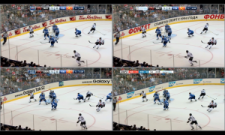Live From NHL All-Star: Digitally Enhanced Dasherboard Takes Next Step With Nine Feeds
Market-specific graphics in different languages can help the league meet global needs
Story Highlights
The NHL is taking over St. Louis this weekend for the NHL All Star Skills tonight and the All Star Game tomorrow. The weekend does more than give fans a chance to watch the best in the sport face off at one event and in unique events: it also affords the league a chance to experiment with advanced technologies. Topping the list this year is Digitally Enhanced Dashboard (DED) technology developed by the NHL and Supponor.
“It’s a completely new way to look at signage,” says Keith Wachtel, chief business officer, NHL. “I do not believe there has been anything that has been this significant in sports signage in the past 30 years. It does come with a whole new way to sell signage, and that can scare some people, but it provides new opportunities.”

DED technology will provide nine feeds, each with different content, to the dasherboards during NHL All-Star Weekend events.
The Supponor system being tested this year requires infrared strips to be placed in the dasherboards at Enterprise Center, home of the Stanley Cup Champion St. Louis Blues, where the event will take place.
Those strips emit IR light that is picked up by the camera lenses and allows the Supponor system to then digitally insert graphic elements over the dasherboard.
“It works flawlessly,” says Wachtel, adding, “but there are still some technological things we need to work through and perfect. Because our boards are rounded and also the camera is shooting through glass, we have challenges the other sports don’t have. But we are confident that isn’t going to be an issue or a problem. It’s really more about showcasing, evaluating, and refining.”
This is not the first time the NHL has worked with the system. In 2016, it was used during the World Cup of Hockey in Canada to deliver four DED feeds: one for the U.S. market, two for the Canadian market (one English, one French Canadian), and a world feed. But the test this weekend is taking things to the next level to better meet global needs.
“What we are doing here is nine feeds,” says Wachtel. Market-specific dasherboard enhancements will be offered for the U.S., Canada (both French and English), the world feed, Russia, Switzerland, Sweden, Czechoslovakia, and Finland.
“We will have brands who activate in those markets using native tongue on the boards in the broadcast,” he adds. “And we see that as a huge opportunity for us, the broadcasters, as well as sponsors. And as we build a global business and have games in China and throughout Europe, we can truly showcase brands.”
The use of the technology opens up new business opportunities for the NHL. Unlike the other big-four leagues, it has a significant number of fans in Canada. And, with 30% of its players from overseas, its fanbase is truly global.
“We can’t monetize anything of significance with our partners in other markets when we have an event in one market,” says Wachtel. “This game is a good example. Our U.S. partners will be able to take advantage of very valuable camera-visible signage with our dasherboards. But, across Canada this weekend, we will have 4 million viewers, which is significant, and yet the likes of Scotiabank or Tim Hortons coffee and our Canadian-only partners are not able to take advantage of it. More important, we can’t monetize it. One of the original thoughts is, wouldn’t it be great if there was technology that could allow us to do that?”
Although the technology is proven out, there is still plenty of work to be done to figure out how to deploy it during the regular season. Cost is one factor, and, according to Wachtel, costs have been cut by 30% since the league first tested the technology at the 2016 World Cup of Hockey in Canada (for that event there were only four feeds). And then, there are some business issues that need to be sorted out, such as how revenues would be handled.
“If we can figure out the right business model, it could be deployed in the ’21-’22 or ’22-’23 season,” he says. “But there are so many different constituents that have to be involved and that we want involved in the decisions: the national and regional broadcasters, the clubs, and, obviously, our sponsors and business partners. But this is a great showcase to the world of the potential, with the hope that, coming out of it, we can spend time with those constituents to figure out can we do it, how best to do it, how we can make revenue, how does that revenue get dispersed, what are the costs, how we can get those down, and truly look at a five- to 10-year business model.”
